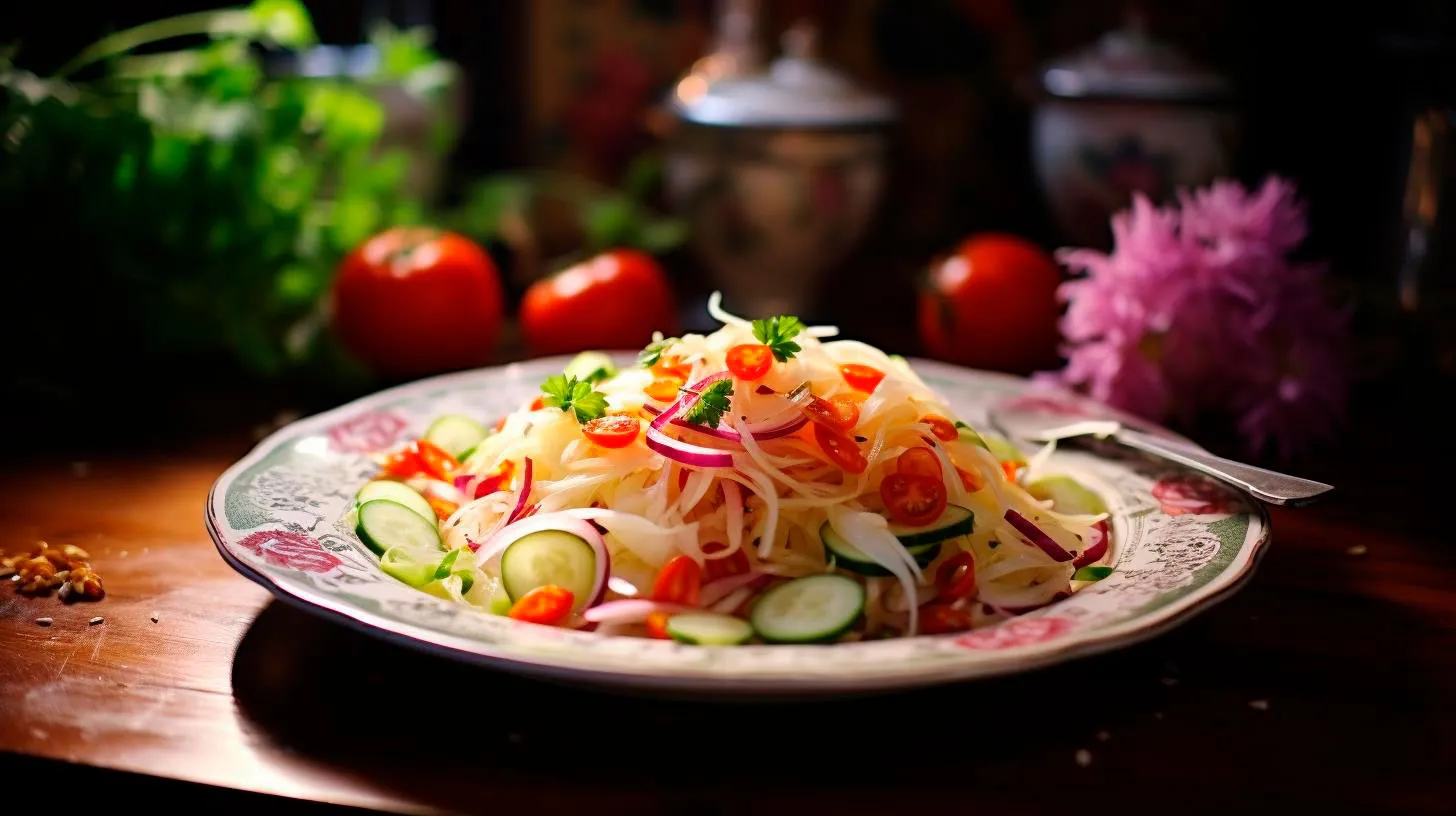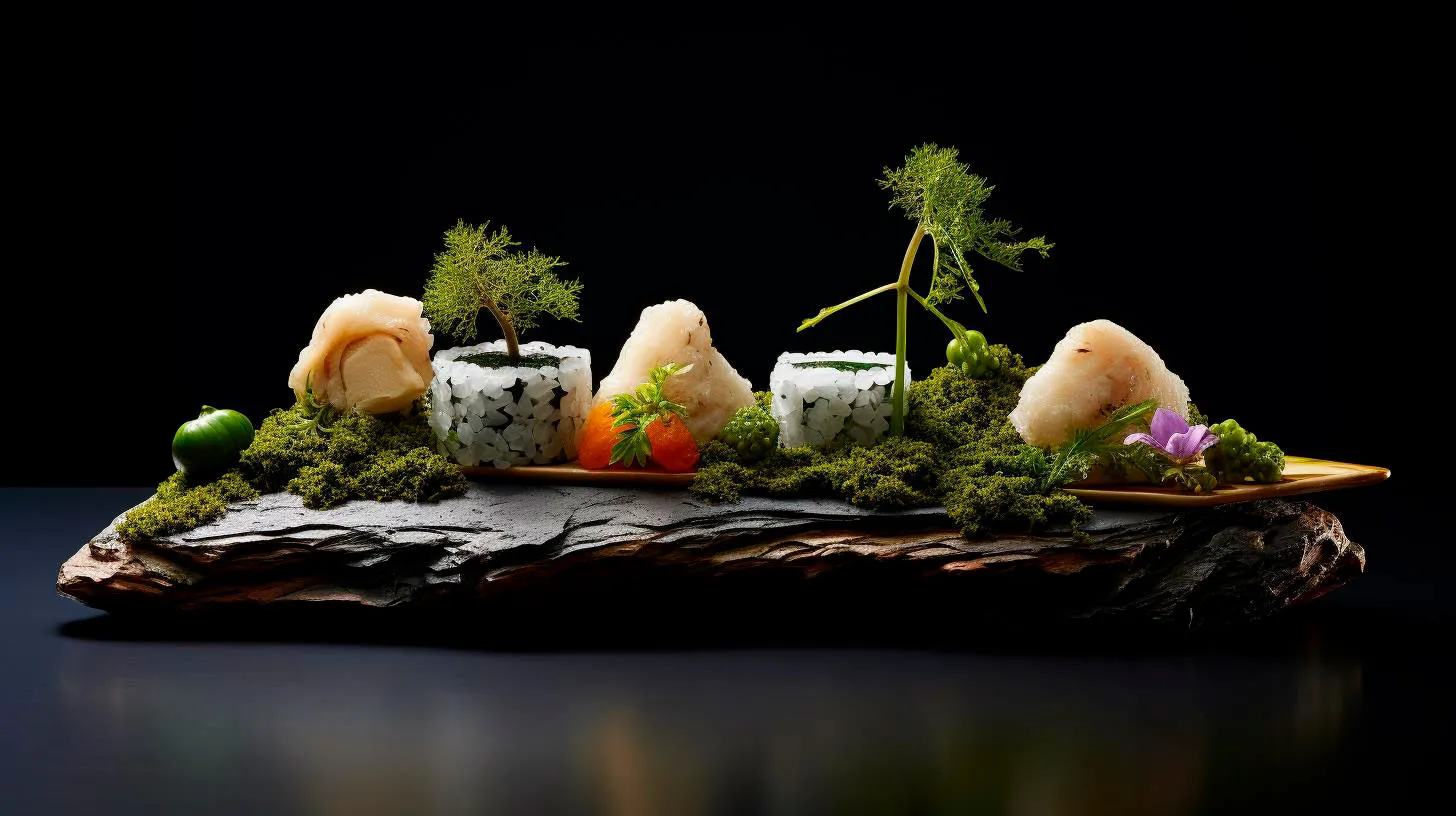From Novice to Nigiri: A Beginner’s Guide to Sushi Making
In this beginner’s guide, we will walk you through the essentials of sushi making, providing you with valuable tips and tricks along the way.
The Basics of Sushi Making
Before getting your hands dirty, let’s start with the basics. Sushi is a traditional Japanese dish that comprises vinegared rice combined with raw or cooked seafood, vegetables, or other ingredients. It is often served with soy sauce, wasabi, and pickled ginger. There are various types of sushi, including maki rolls, nigiri, sashimi, and more. For beginners, it is recommended to start with simpler options like maki rolls and nigiri.
Essential Tools and Ingredients
Now that we’ve covered the fundamentals, let’s dive into the tools and ingredients you’ll need to get started:
- Bamboo mat: For rolling your sushi, a bamboo mat, also known as a makisu, is essential. It helps shape and compress the sushi rolls.
- Sushi rice: The foundation of sushi making, sushi rice needs to be short-grained and cooked to perfection. It should be slightly sticky for easy rolling.
- Nori (seaweed): Nori is the dried seaweed sheet that wraps around the sushi rolls.
- Sashimi-grade fish: If you’re planning to make nigiri, sashimi-grade fish is crucial. Visit a trusted fish market to ensure the safety and freshness of your ingredients.
- Vegetables and fillings: Get creative with your rolls by incorporating fresh vegetables like cucumber, avocado, and carrots. You can also add proteins like cooked shrimp or crab meat.
- Sauces and condiments: Soy sauce, wasabi, and pickled ginger are essential accompaniments to enhance the flavors of your sushi.
Step-by-Step Guide to Making Sushi
Now that you have everything you need let’s start assembling your sushi masterpiece:
Step 1: Prepare Sushi Rice
Become a rice master by following these steps:
- Wash the sushi rice under cold water until the water runs clear.
- Cook the rice according to the instructions on the package.
- While the rice is still hot, transfer it to a large wooden or glass bowl.
- Gradually add sushi vinegar, gently folding the rice to ensure even distribution. Be careful not to mash the grains.
- Cover the rice with a damp cloth to prevent it from drying out while you prepare other ingredients.
Step 2: Prepare the Fillings
Choose your favorite fillings and slice them into thin strips or bite-sized pieces. For ease of rolling, it’s advisable to cut the fillings into uniform shapes.
Step 3: Roll it Up!
Now comes the exciting part – rolling your sushi:
- Lay the bamboo mat flat on a clean surface and place a sheet of nori on top.
- Dip your hands in water to keep the rice from sticking.
- Scoop a handful of sushi rice onto the nori and spread it evenly, leaving a small border on one edge.
- Place your chosen fillings on top of the rice, arranging them in a straight line.
- Using the bamboo mat, start rolling the sushi from the edge with the fillings, applying gentle pressure to create a tight roll.
- Once the roll is complete, use a sharp knife to slice it into bite-sized pieces. Wetting the knife between cuts helps achieve clean slices.
Step 4: Making Nigiri
If you’re keen to master the art of nigiri, follow these steps:
- Dip your hands in water and sprinkle a pinch of salt over them to prevent sticking.
- Taking a small amount of sushi rice, gently form it into a rectangular shape.
- Place a slice of sashimi-grade fish on top of the rice, gently pressing it to adhere.
- Repeat the process with different toppings and enjoy the variety of flavorful nigiri bites.
Key Takeaways for Sushi Making
As you embark on your sushi-making journey, keep the following key takeaways in mind:
- Practice makes perfect: Don’t be discouraged if your first attempts are not flawless. Sushi making takes time and practice to master.
- Use fresh ingredients: To ensure the best flavors and textures, opt for fresh, high-quality ingredients from reputable sources.
- Experiment with flavors: Feel free to get creative with your fillings, sauces, and seasonings. Explore new combinations to find your favorite sushi creations.
- Presentation matters: Sushi is not only about taste but also presentation. Take your time to arrange your creations beautifully for an aesthetically pleasing dining experience.
- Enjoy the process: Sushi making is not only about the end result but also about enjoying the journey. Have fun and embrace the art of sushi making.
Now that you have the foundation of sushi making, it’s time to roll up your sleeves and embark on this exciting culinary adventure. With practice, patience, and a pinch of creativity, you’ll soon be impressing friends and family with your homemade sushi creations. Happy rolling!
Unveiling the Secrets of Sushi Masters: Expert Techniques and Tricks
In this article, we delve into the secrets of sushi masters, uncovering their expert techniques and tricks that make their creations stand out. So, let’s dive into the world of sushi and learn what it takes to become a sushi master!
Understanding Sushi: A Brief Introduction
Sushi, originating from Japan, is a dish primarily composed of vinegared rice served with various ingredients such as raw or cooked seafood, vegetables, and sometimes even tropical fruits. It is important to note that sushi refers to the rice used in the dish, while sashimi denotes the raw fish or seafood served without rice.
Sushi is typically enjoyed with soy sauce, wasabi, and pickled ginger. It offers a mouthwatering amalgamation of flavors, emphasizing the subtlety and freshness of the ingredients. Sushi can be presented in different forms, including nigiri (hand-pressed), maki (rolled), and sashimi (thinly sliced raw fish). Each style requires precise techniques and attention to detail to achieve perfection.
The Secret Techniques of Sushi Masters
1. Rice Preparation
- Sushi rice is the foundation of any great sushi dish. It must be cooked to perfection and seasoned with a delicate balance of rice vinegar, salt, and sugar.
- To ensure the rice grains remain firm yet tender, a high-quality short-grain rice variety like Japanese sushi rice is often preferred.
2. Knife Skills
- A sushi chef’s knife skills are critical. They master the art of wielding a sharp, long sushi knife to make precise cuts, creating uniform slices of fish, vegetables, and even the sushi rolls themselves.
- Years of training are required to acquire the skill to slice ingredients with finesse, thus enhancing the visual appeal of the sushi.
3. Fresh and Top-Quality Ingredients
- Sushi masters prioritize sourcing the freshest and finest ingredients to ensure the highest quality and taste.
- They maintain strong relationships with trusted suppliers and often obtain ingredients directly from local fish markets.
4. Artistic Presentation
- Sushi is not just about taste; it is an art form that emphasizes presentation. Sushi masters use their creativity to craft visually stunning dishes that are pleasing to the eye.
- From arranging colorful ingredients with precision to the meticulous shaping of sushi rolls, every element of the presentation is carefully considered.
The Advantages of Sushi Mastery
Mastering the art of sushi brings numerous advantages, including the following:
1. Culinary Prestige
Becoming a sushi master elevates your culinary skills and provides recognition within the culinary industry. It allows you to stand out from the crowd, showcasing your talent and expertise.
2. Creative Expression
Sushi-making is an opportunity for chefs to express their creativity. As a sushi master, you have the freedom to experiment with unique flavor combinations and innovative presentations, making each dish a work of art.
3. Job Opportunities
Sushi’s growing popularity has led to an increasing demand for skilled sushi chefs. Mastering the techniques and tricks helps you secure lucrative job opportunities at top-notch restaurants, hotels, or even starting your own sushi business.
4. Cultural Appreciation
Sushi is deeply rooted in Japanese culture. By perfecting the art of sushi, you gain a deeper understanding and appreciation of Japanese traditions, history, and culinary heritage, enriching your culinary journey.
Key Takeaways
Unveiling the secrets of sushi masters reveals their dedication, skill, and passion for this revered culinary art. Remember these key takeaways as you delve into the world of sushi:
- Sushi requires meticulous attention to detail and years of practice to master.
- Choose high-quality ingredients for the best sushi experience.
- Presentation is an integral part of sushi’s allure.
- Master your knife skills to achieve precise cuts.
- Enjoy the culinary prestige and career opportunities that come with sushi mastery.
Embark on your sushi-making journey with respect for the craft, a curious palate, and a desire to create edible works of art that bring joy to both yourself and those who taste your creations.
Mastering the Art of Sushi Making: Pro Techniques and Tips
In this article, we will dive into the world of sushi making and unveil the pro techniques and tips that will help you master this incredible art.
The Basics of Sushi Making
Before we explore the pro techniques, let’s start with the basics of sushi making. The core components of sushi include sticky rice, fresh fish or other seafood, vegetables, and seaweed. Here are some key points to keep in mind:
- Choose high-quality ingredients: To achieve the best results, select fresh fish and vegetables. The texture and taste of sushi heavily rely on the quality of the ingredients.
- Perfect the rice: Sushi rice is the foundation of every sushi roll. Make sure to cook it properly and season it with rice vinegar, salt, and sugar to enhance its flavor.
- Master the art of rolling: Rolling sushi may seem tricky at first, but with practice, you’ll get the hang of it. Use a bamboo mat to tightly roll the sushi and ensure all the ingredients are securely encased.
- Invest in quality tools: Having the right tools can make a significant difference in your sushi-making journey. A sharp knife, bamboo mat, and sushi chef’s knife are a few essentials to consider.
Pro Techniques for Perfect Sushi
Now that you have a grasp of the basics, let’s delve into the pro techniques that will take your sushi making skills to the next level:
1. Knife Skills
One of the key aspects of sushi making is the precise and skillful cutting of fish and vegetables. A sharp sushi chef’s knife is essential for achieving thin and uniform slices. Remember:
- Hold the knife properly: Grip the knife handle firmly, and let the blade do the work without applying excessive pressure.
- Keep the blade wet: Wetting the blade before slicing helps in achieving clean cuts and prevents the ingredients from sticking.
- Practice makes perfect: The more you practice your knife skills, the more precise and confident you’ll become in slicing the ingredients.
2. Fish Selection
Choosing the right fish is crucial for a flavorful sushi experience. Here are some things to consider:
- Freshness is key: Opt for fish that smells fresh, has clear eyes, and bright red gills. Avoid fish that appears dull or has a strong odor.
- Consider sustainability: To support sustainable fishing practices, choose fish that are not overfished or endangered.
- Experiment with different flavors: Tuna and salmon are popular choices, but don’t be afraid to explore other fish varieties to diversify your sushi platter.
3. Presentation and Garnishing
Mastering the art of sushi also includes presenting your creations in an appealing way. Consider these tips:
- Create visually pleasing arrangements: Play with colors and textures, and arrange your sushi rolls elegantly on a plate.
- Garnish with finesse: Finely chopped scallions, sesame seeds, tobiko (flying fish roe), and wasabi can add both flavor and visual interest to your sushi.
- Experiment with sauces: Drizzle some soy sauce, spicy mayo, or eel sauce on your sushi rolls to elevate the taste and presentation.
Key Takeaways
Making sushi like a pro requires practice, dedication, and attention to detail. Here are the key takeaways to remember:
- Choose high-quality ingredients to enhance the flavor of your sushi.
- Perfect the art of rolling to ensure your sushi maintains its shape and doesn’t fall apart.
- Hone your knife skills to achieve precise and uniform slices.
- Experiment with different fish varieties to expand your sushi-making repertoire.
- Presentation and garnishing are essential for visually appealing sushi platters.
By embracing these pro techniques and tips, you can embark on an exciting journey to master the art of sushi making. So, roll up your sleeves, grab your sushi mat, and let your creativity flow!
Secret Ingredients: Discovering the Key to Perfect Sushi
Join us as we uncover the secret ingredients that can take your sushi game to the next level!
The Importance of Fresh Fish
When it comes to sushi, freshness is paramount. Using the freshest fish not only enhances the taste but also ensures the safety of consuming raw fish. Fresher fish possess a certain quality that elevates the sushi experience, making it melt in your mouth. So, how can you identify fresh fish for your sushi?
- Check for bright and clear eyes: Fish with cloudy or bloodshot eyes is a telltale sign of not being fresh.
- Firmness: Gently press the fish to check its texture. Fresh fish will spring back, while older fish will leave an indentation.
- Smell: Opt for fish with an oceanic aroma rather than a strong, fishy smell.
Remember, fresh ingredients are the foundation of perfect sushi. Without them, no amount of seasoning or technique can save your dish.
Quality Rice: The Glue That Holds It All Together
While the fish steals most of the limelight, the rice in sushi plays a crucial role in balancing the flavors and ensuring a harmonious gastronomic experience. Here’s what you need to know about sushi rice:
- Grain Texture: Choose short-grained rice as it is essential for achieving the perfect sticky texture.
- Vinegar Infusion: The rice is seasoned with a special vinegar-based mixture that gives it a tangy flavor. Strike the right balance between sweetness and acidity to create a delectable harmony.
- Cooking Technique: Properly cooking sushi rice is an art in itself. Ensure that each grain is evenly cooked and well-coated with the vinegar mixture.
Sushi rice is the adhesive, bringing together all the other ingredients in your roll. Neglecting it or using subpar rice can ruin the entire sushi experience.
Mastering the Art of Wasabi and Soy Sauce
While sushi aficionados are no strangers to the fiery green wasabi and savory soy sauce, it’s crucial to understand how these condiments can impact your sushi-eating experience.
- Wasabi: This pungent green paste is made by grinding the root of the Japanese horseradish plant. It provides a distinct spiciness that can clear your sinuses and elevate the flavors of your sushi. However, apply it sparingly to avoid overpowering the delicate taste of the fish.
- Soy Sauce: Dip your sushi lightly in soy sauce to enhance the umami flavor. Avoid soaking it for too long, as it can make the rice soggy and overshadow the subtle fish flavors.
By mastering the art of using these condiments, you can tailor each bite of sushi to your liking, creating a personalized culinary experience.
Key Takeaways
As we uncover the secret ingredients behind perfect sushi, let’s recap the key takeaways:
- Use only the freshest fish to ensure the best taste and safety.
- Choose short-grained rice and master the art of cooking and seasoning sushi rice.
- Balance the spiciness of wasabi and the umami of soy sauce to enhance the overall flavor profile.
Remember, attention to detail and quality ingredients are paramount when it comes to creating outstanding sushi. Experiment, refine your techniques, and let your taste buds be your guide on this delightful culinary journey! Happy sushi-making!


